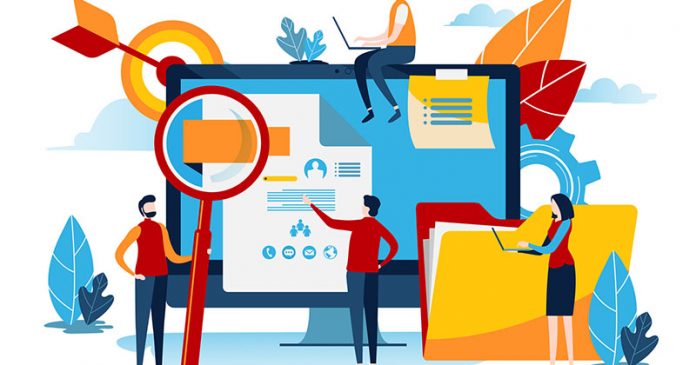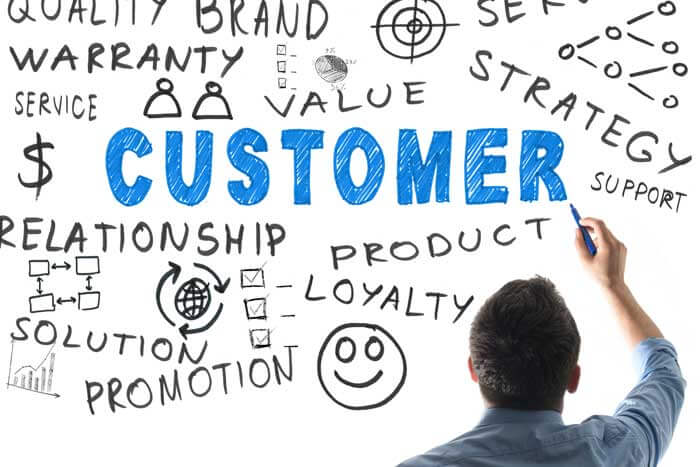Despite digital marketing’s relative infancy, organizations across industries recognize that these emerging channels require significant attention. From smartphones to social media, digital has become an integral element in the way consumers operate day-to-day.
Yet, while all companies currently reside at different levels of digital adoption, all run the risk of committing the very faux pas that may hinder future progress and success. Here, we examine the 10 most common digital marketing mistakes in the space today, while also offering advice on how companies can rectify their approach as they work to realign their mindset:
1. Traditional marketing and digital marketing teams frequently operate as two separate entities. Just as entire organizations cannot function properly with siloed departments in place, marketing teams cannot succeed if traditional and digital channels remain divided. Thus, these disparate teams act cautiously, disregarding innovation and advanced strategies as neither group wants to run the risk of losing budget to the more effective channel, says Craig Kallin, senior vice president of business development and marketing at Primacy.
What to do: Break down silos to develop an informed cross-channel strategy. If companies truly want to run integrated, cross-channel campaigns, Kallin notes, they must create an organizational structure that supports that very philosophy. Ultimately, such integrated teams can leverage historical data captured by traditional means over the years to guide digital programs and initiatives, while also leveraging digital to test new approaches and programs before investing in traditional media.
2. Companies often attempt to rush progress, inevitably implementing the wrong technology and creating confusion. Many brands lack vision, planning, and commitment when they first enact their digital marketing strategies. Thus, marketers rush to choose a product or technology that may not be able to solve the important problems at hand, says Peter Wells, senior vice president of global sales at Certona. Implementing the incorrect systems at the start may inevitably warrant another partnership or product to manage in the future, leading teams to underperform.
What to do: Establish goals, develop plans, and research available technologies prior to adoption. Before companies can verify the proper technology, they must establish goals and develop plans that will guide their journey forward. As Wells emphasizes, jumping on the slick new product bandwagon may become costly. Therefore, once KPIs have been determined, marketers must thoroughly research the available technologies in the market to ensure that the solutions is the right fit for their needs, will integrate with existing platforms, and can scale with their growing needs.
3. Digital marketers implement programs simply because they can. Though counterintuitive, many digital marketers implement programs that lack purpose and diminish trust. For instance, marketers will create loyalty programs despite the fact that they provide no loyalty incentives whatsoever. They look to collect customer data, but they fail to offer any rewards or tailored engagements in return.
What to do: Make sure all initiatives drive value and support trust. Poorly planned and unsupported initiatives may drive customers to the competition, as they detract from the ability to truly engage and convert consumers. Thus, digital marketers must refrain from clinging to the latest trends because focusing on fewer initiatives that deliver value will positively impact trust more than any scattered strategy in the space.
4. Brands produce content for the sake of having content rather than offer relevant messaging that speaks to customers’ specific interests. As Navin Nagiah, CEO of DNN, notes, most brands believe the ability to post and share content across channels means they must produce an endless flood of information. Marketers understand that customer interactions take place across all touchpoints, leading them to believe that they must provide a constant stream of content no matter the platform, for they believe that visibility will result in engagement when, in reality, this strategy typically diminishes interest.
What to do: Post engaging content that demonstrates the importance of quality over quantity. Because content has clearly become an integral element of the digital marketing experience, companies must approach this trend carefully, as other brands have also hopped on the bandwagon. Instead of focusing on quantity, marketers must focus on the quality of their content. Engaging material has the power to strengthen customer loyalty and advocacy, while mediocre work will likely have the opposite effect.
5. Marketers think they can (and should) monitor and measure every point possible. Though marketers now have the ability to gather, analyze, and act upon data across the customer lifecycle, many will find that the power of digital can also hinder progress. “Most find themselves drowning in a sea of unnecessary data because they insist on tracking every point imaginable,” says Michael Behrens, vice president of eMarketing at WebMetro, the digital marketing arm of Revana Growth Services. “Ultimately, however, not all customer information and behavioral data can be brought to action, nor should it be.”
What to do: Take one step at a time to determine which touchpoints and metrics truly impact the bottom line. Instead, companies must develop a better balance via constant testing and strategy reconfiguration. Not every touchpoint will yield information that pertains to the brand’s bottom line, and these relevant touchpoints are likely to change as the customer experience evolves. As Nagiah highlights, marketers must climb the staircase to success, for there’s no elevator. But, by putting one foot in front of the other, they will soon reach the top.
6. Companies dream of an omnichannel strategy, but fail to centralize the incoming digital data. For years, marketers have romanticized the notion of an omnichannel experience. Yet, while many talk about breaking down the departmental silos that stall progress, few have successfully implemented this unified approach to customer experience and data collection, as companies typically lack a cohesive organizational structure, as well as the technological infrastructure to bring all incoming information together under one roof.
What to do: Integrate customer information to understand the customer experience and drive strategic development. Ultimately, data centralization will be the primary component standing between success and failure, for companies that neglect to integrate disparate systems are destined to struggle, hindering customer experience. “When it comes to data centralization, organizations must invest in the integrated technologies that enable marketers to be more efficient and effective with regard to actionable decision-making,” Behrens emphasizes. “Ideally, companies will have such an infrastructure in place from the start, as those who fail to implement such systems are destined to fight an uphill battle against resource decisions, siloed information, and enterprisewide inefficiencies. Unfortunately, however, such is the case for many on the journey toward digital proficiency, as few brands currently have the ability to blend incoming data across the entire organization.”
7. Marketers rarely look to consumer behavior for guidance, ultimately failing to uphold the brand promise. Despite the fact that consumer behavior ultimately drives brand success or failure, many neglect to tap into said actions to derive insight from this incoming data. As Wells highlights, these companies rush to implement the latest strategy because it’s the newest trend. But seeking solutions from this “business first” standpoint signals the wrong approach, as marketers disregard their own customers’ needs, desires, bad experiences, and demands for digital engagement.
What to do: Focus on customer centricity to boost trust and deliver ROI. By organizing campaigns that build upon their own customer insight, brands can easily strengthen trust in order to cultivate the types of relationships necessary for continued success. “Digital campaigns can’t succeed based on Big Data and analytics alone,” says Steve Warren, vice president and general manager, Teradata Interactive, at Teradata. “Instead, it’s clear and actionable customer behaviors that you need to consider. At the core of every marketer’s mission is delivering the perfectly tailored message to the intended target. But remember, digital marketing will always be secondary to an actual relationship. Try to forget about B2B or B2C and just be real.”
8. Executives invest in the necessary technology, but not the resources that drive success. While most leaders now agree that digital channels require special attention, many invest time and money into integrating the proper systems, yet few invest in the necessary resources. Companies often thrust management responsibilities on their already tapped-out workforces, setting the initiative up for failure from the onset.
What to do: Create teams that specifically care for and carry out the brand’s digital strategy. Technology isn’t going to operate itself. Instead, strategic development must also include finding the right person or team of people with the necessary skillset and bandwidth to make the investment worthwhile. Ultimately, brands must recognize that technology cannot replace employees, for the customer experience will always require the human touch.
9. Brands neglect to establish one program manager to monitor metrics and goals. Because companies often implement marketing initiatives with great speed, many use this “bias for action” as an excuse for not taking the time to develop comprehensive plans and well-defined campaigns with specific objectives. Thus, employees begin operating within their siloed departments without one program manager to oversee and deliver leads or sales.
What to do: Understand how each digital asset performs and its contribution to the end goal. By putting one program manager in the position to supervise all marketing activity, companies will ultimately come to understand the role of each digital asset with regard to how they individually and collectively impact the broader campaign, Kallin highlights. Thus, brands can easily create one comprehensive snapshot of the campaign and demonstrate how each asset contributes to the end goal so the program manager may effectively shift budget dollars to maximize campaign performance.
10. Marketing teams lack the enterprisewide buy-in needed to advance digital strategy development. As with every enterprisewide initiative, digital marketing requires top-down buy-in if said strategies hope to succeed. Implementation isn’t something that can be turned on or off by flipping the switch. Marketers need continued support so they may take slow, but steady steps toward success.
What to do: Gain executive buy-in and build partner relationships to enable a unified marketing strategy. True commitment must be supported from the top, or else investments in technology, partnerships, infrastructure, and resources will likely lack the fortitude to sustain long-term success. Thus, marketers must establish a clear set of strategic goals and develop a plan with launch milestones and success measurements to ensure all levels of the company are in the loop regarding progress. Developing partnerships with best-in-class providers will also enable marketers to integrate solutions for scalability and expansion. With said relationships in place, companies will be well on their way to establishing a unified marketing strategy that values and benefits the entire organization.
Despite digital marketing’s relative infancy, organizations across industries recognize that these emerging channels require significant attention. From smartphones to social media, digital has become an integral element in the way consumers operate day-to-day.
Yet, while all companies currently reside at different levels of digital adoption, all run the risk of committing the very faux pas that may hinder future progress and success. Here, we examine the 10 most common digital marketing mistakes in the space today, while also offering advice on how companies can rectify their approach as they work to realign their mindset:
1. Traditional marketing and digital marketing teams frequently operate as two separate entities. Just as entire organizations cannot function properly with siloed departments in place, marketing teams cannot succeed if traditional and digital channels remain divided. Thus, these disparate teams act cautiously, disregarding innovation and advanced strategies as neither group wants to run the risk of losing budget to the more effective channel, says Craig Kallin, senior vice president of business development and marketing at Primacy.
What to do: Break down silos to develop an informed cross-channel strategy. If companies truly want to run integrated, cross-channel campaigns, Kallin notes, they must create an organizational structure that supports that very philosophy. Ultimately, such integrated teams can leverage historical data captured by traditional means over the years to guide digital programs and initiatives, while also leveraging digital to test new approaches and programs before investing in traditional media.
2. Companies often attempt to rush progress, inevitably implementing the wrong technology and creating confusion. Many brands lack vision, planning, and commitment when they first enact their digital marketing strategies. Thus, marketers rush to choose a product or technology that may not be able to solve the important problems at hand, says Peter Wells, senior vice president of global sales at Certona. Implementing the incorrect systems at the start may inevitably warrant another partnership or product to manage in the future, leading teams to underperform.
What to do: Establish goals, develop plans, and research available technologies prior to adoption. Before companies can verify the proper technology, they must establish goals and develop plans that will guide their journey forward. As Wells emphasizes, jumping on the slick new product bandwagon may become costly. Therefore, once KPIs have been determined, marketers must thoroughly research the available technologies in the market to ensure that the solutions is the right fit for their needs, will integrate with existing platforms, and can scale with their growing needs.
3. Digital marketers implement programs simply because they can. Though counterintuitive, many digital marketers implement programs that lack purpose and diminish trust. For instance, marketers will create loyalty programs despite the fact that they provide no loyalty incentives whatsoever. They look to collect customer data, but they fail to offer any rewards or tailored engagements in return.
What to do: Make sure all initiatives drive value and support trust. Poorly planned and unsupported initiatives may drive customers to the competition, as they detract from the ability to truly engage and convert consumers. Thus, digital marketers must refrain from clinging to the latest trends because focusing on fewer initiatives that deliver value will positively impact trust more than any scattered strategy in the space.
4. Brands produce content for the sake of having content rather than offer relevant messaging that speaks to customers’ specific interests. As Navin Nagiah, CEO of DNN, notes, most brands believe the ability to post and share content across channels means they must produce an endless flood of information. Marketers understand that customer interactions take place across all touchpoints, leading them to believe that they must provide a constant stream of content no matter the platform, for they believe that visibility will result in engagement when, in reality, this strategy typically diminishes interest.
What to do: Post engaging content that demonstrates the importance of quality over quantity. Because content has clearly become an integral element of the digital marketing experience, companies must approach this trend carefully, as other brands have also hopped on the bandwagon. Instead of focusing on quantity, marketers must focus on the quality of their content. Engaging material has the power to strengthen customer loyalty and advocacy, while mediocre work will likely have the opposite effect.
5. Marketers think they can (and should) monitor and measure every point possible. Though marketers now have the ability to gather, analyze, and act upon data across the customer lifecycle, many will find that the power of digital can also hinder progress. “Most find themselves drowning in a sea of unnecessary data because they insist on tracking every point imaginable,” says Michael Behrens, vice president of eMarketing at WebMetro, the digital marketing arm of Revana Growth Services. “Ultimately, however, not all customer information and behavioral data can be brought to action, nor should it be.”
What to do: Take one step at a time to determine which touchpoints and metrics truly impact the bottom line. Instead, companies must develop a better balance via constant testing and strategy reconfiguration. Not every touchpoint will yield information that pertains to the brand’s bottom line, and these relevant touchpoints are likely to change as the customer experience evolves. As Nagiah highlights, marketers must climb the staircase to success, for there’s no elevator. But, by putting one foot in front of the other, they will soon reach the top.
6. Companies dream of an omnichannel strategy, but fail to centralize the incoming digital data. For years, marketers have romanticized the notion of an omnichannel experience. Yet, while many talk about breaking down the departmental silos that stall progress, few have successfully implemented this unified approach to customer experience and data collection, as companies typically lack a cohesive organizational structure, as well as the technological infrastructure to bring all incoming information together under one roof.
What to do: Integrate customer information to understand the customer experience and drive strategic development. Ultimately, data centralization will be the primary component standing between success and failure, for companies that neglect to integrate disparate systems are destined to struggle, hindering customer experience. “When it comes to data centralization, organizations must invest in the integrated technologies that enable marketers to be more efficient and effective with regard to actionable decision-making,” Behrens emphasizes. “Ideally, companies will have such an infrastructure in place from the start, as those who fail to implement such systems are destined to fight an uphill battle against resource decisions, siloed information, and enterprisewide inefficiencies. Unfortunately, however, such is the case for many on the journey toward digital proficiency, as few brands currently have the ability to blend incoming data across the entire organization.”
7. Marketers rarely look to consumer behavior for guidance, ultimately failing to uphold the brand promise. Despite the fact that consumer behavior ultimately drives brand success or failure, many neglect to tap into said actions to derive insight from this incoming data. As Wells highlights, these companies rush to implement the latest strategy because it’s the newest trend. But seeking solutions from this “business first” standpoint signals the wrong approach, as marketers disregard their own customers’ needs, desires, bad experiences, and demands for digital engagement.
What to do: Focus on customer centricity to boost trust and deliver ROI. By organizing campaigns that build upon their own customer insight, brands can easily strengthen trust in order to cultivate the types of relationships necessary for continued success. “Digital campaigns can’t succeed based on Big Data and analytics alone,” says Steve Warren, vice president and general manager, Teradata Interactive, at Teradata. “Instead, it’s clear and actionable customer behaviors that you need to consider. At the core of every marketer’s mission is delivering the perfectly tailored message to the intended target. But remember, digital marketing will always be secondary to an actual relationship. Try to forget about B2B or B2C and just be real.”
8. Executives invest in the necessary technology, but not the resources that drive success. While most leaders now agree that digital channels require special attention, many invest time and money into integrating the proper systems, yet few invest in the necessary resources. Companies often thrust management responsibilities on their already tapped-out workforces, setting the initiative up for failure from the onset.
What to do: Create teams that specifically care for and carry out the brand’s digital strategy. Technology isn’t going to operate itself. Instead, strategic development must also include finding the right person or team of people with the necessary skillset and bandwidth to make the investment worthwhile. Ultimately, brands must recognize that technology cannot replace employees, for the customer experience will always require the human touch.
9. Brands neglect to establish one program manager to monitor metrics and goals. Because companies often implement marketing initiatives with great speed, many use this “bias for action” as an excuse for not taking the time to develop comprehensive plans and well-defined campaigns with specific objectives. Thus, employees begin operating within their siloed departments without one program manager to oversee and deliver leads or sales.
What to do: Understand how each digital asset performs and its contribution to the end goal. By putting one program manager in the position to supervise all marketing activity, companies will ultimately come to understand the role of each digital asset with regard to how they individually and collectively impact the broader campaign, Kallin highlights. Thus, brands can easily create one comprehensive snapshot of the campaign and demonstrate how each asset contributes to the end goal so the program manager may effectively shift budget dollars to maximize campaign performance.
10. Marketing teams lack the enterprisewide buy-in needed to advance digital strategy development. As with every enterprisewide initiative, digital marketing requires top-down buy-in if said strategies hope to succeed. Implementation isn’t something that can be turned on or off by flipping the switch. Marketers need continued support so they may take slow, but steady steps toward success.
What to do: Gain executive buy-in and build partner relationships to enable a unified marketing strategy. True commitment must be supported from the top, or else investments in technology, partnerships, infrastructure, and resources will likely lack the fortitude to sustain long-term success. Thus, marketers must establish a clear set of strategic goals and develop a plan with launch milestones and success measurements to ensure all levels of the company are in the loop regarding progress. Developing partnerships with best-in-class providers will also enable marketers to integrate solutions for scalability and expansion. With said relationships in place, companies will be well on their way to establishing a unified marketing strategy that values and benefits the entire organization.










